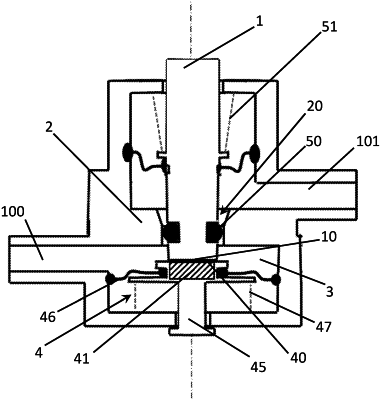| CPC F16K 17/042 (2013.01) [F16K 31/003 (2013.01); F16K 31/084 (2013.01); F16K 31/086 (2013.01); F16K 31/1262 (2013.01); F16K 31/1266 (2013.01)] | 9 Claims |

|
1. A valve for a fluid, comprising
a valve body and a valve seat;
a fluid chamber for receiving the fluid; and
a holding element,
wherein the valve seat encloses a fluid passage for passage of the fluid out of the fluid chamber,
wherein the valve body and the holding element are in operative connection with the fluid received in the fluid chamber,
wherein the holding element exerts a holding force on the valve body, the holding force acting in a direction towards the valve seat,
wherein an effective surface facing the fluid chamber is associated with the valve body,
wherein in the event that the fluid received in the fluid chamber acts on the effective surface of the valve body with a force or a pressure above a limit value predefined for the valve body, the valve body moves away from the valve seat,
wherein an effective surface facing the fluid chamber is associated with the holding element,
wherein in the event that the fluid received in the fluid chamber acts on the effective surface of the holding element with a force or a pressure above a limit value predefined for the holding element, the holding force acting on the valve body decreases,
wherein the valve body and/or the holding element is/are configured and/or arranged such that the fluid received in the fluid chamber acts on the holding element more strongly and/or earlier than on the valve body,
wherein the valve body and the holding element are configured and arranged such that the valve body and the holding element move in different directions under the action of the fluid,
wherein the holding force decreases in the event that a distance between the holding element and the valve body increases,
wherein a magnetic attraction force acts between the holding element and the valve body, and
wherein the valve body and the holding element are configured and arranged such that reducing the holding force has the effect that a lower pressure is sufficient to cause the valve body to move out of the valve seat.
|